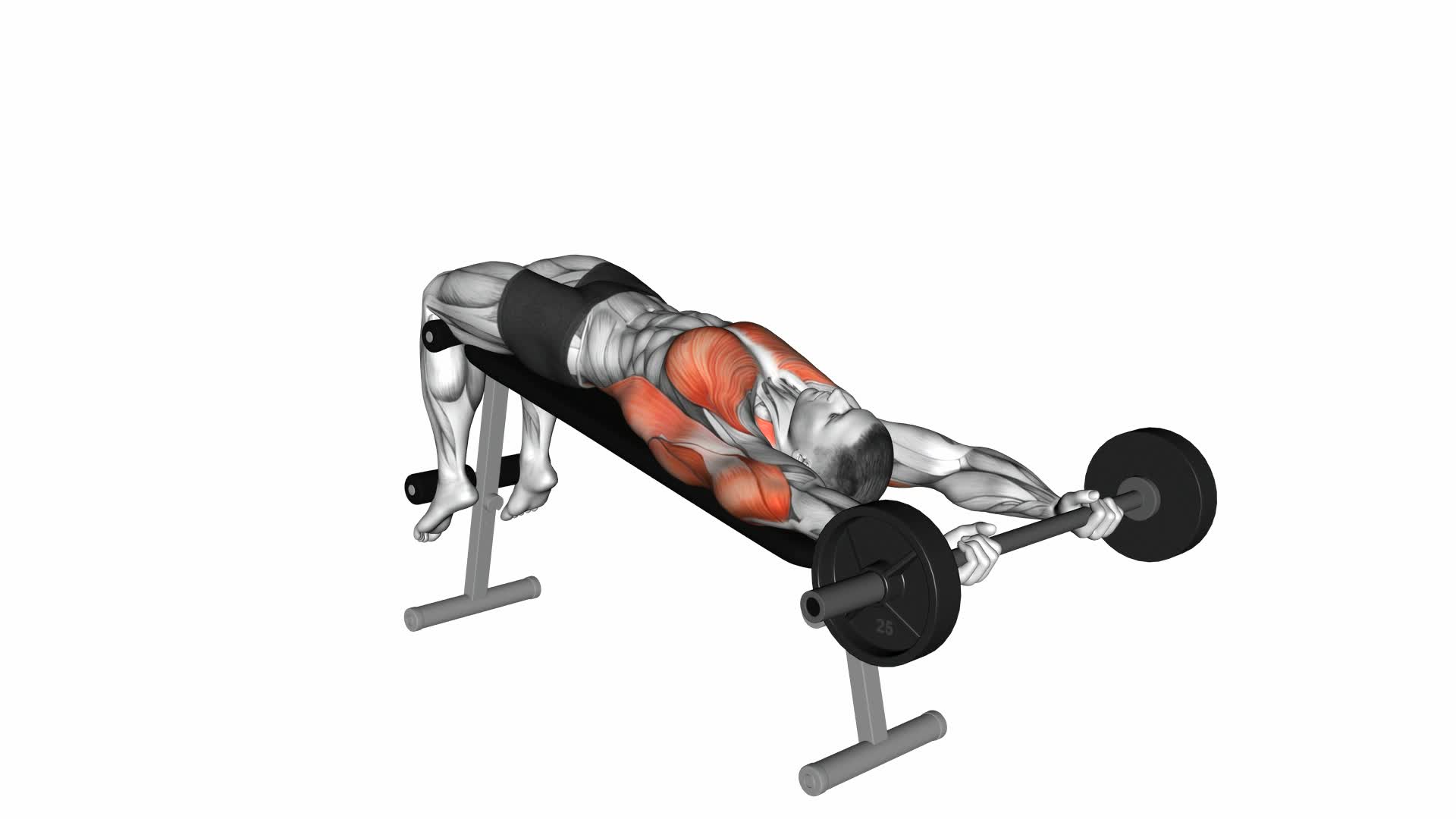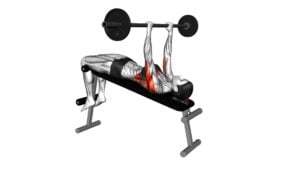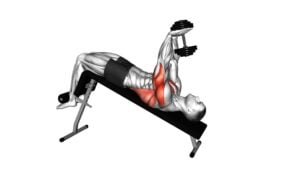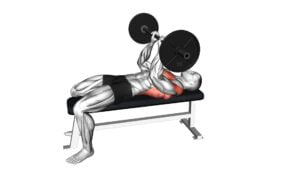Barbell Decline Pullover – Video Exercise Guide & Tips

Looking to build a stronger upper body?
Watch This Exercise Video
Get ready to try the barbell decline pullover! In this exercise, you'll target your chest, back, and shoulders all at once.
By following proper form and technique, you'll maximize the benefits and avoid common mistakes.
With variations and modifications to suit your fitness level, you can customize this workout to your needs.
Safety is important, so make sure to take precautions and watch the video guide for a step-by-step demonstration.
Let's get started!
Key Takeaways
- The barbell decline pullover targets multiple muscle groups, including the chest, back, and shoulders.
- Proper form and technique, such as maintaining a stable spine and controlling the movement, are crucial for maximizing results and preventing injuries.
- Breathing properly during the exercise helps provide stability and engage the core muscles.
- Modifications and variations can be made based on fitness levels and goals, such as adjusting the weight, range of motion, and performing on an incline bench.
Benefits of the Barbell Decline Pullover
One key benefit of the Barbell Decline Pullover is that it targets multiple muscle groups simultaneously. This exercise is highly effective for muscle activation as it engages the chest, back, and shoulder muscles. By incorporating the decline position, it intensifies the workout by placing more emphasis on the lower chest and upper back muscles. The Barbell Decline Pullover also activates the triceps and core muscles, making it a comprehensive exercise for building upper body strength.
In addition to the muscle activation benefits, the Barbell Decline Pullover also emphasizes proper breathing technique. During the exercise, it's important to inhale deeply as you lower the barbell towards your chest, and exhale forcefully as you push the barbell back up. This breathing pattern helps to stabilize your core and increase your overall strength and power output.
Proper form and technique are crucial for maximizing the benefits of the Barbell Decline Pullover. It's important to maintain a stable and neutral spine throughout the exercise, keeping your shoulders back and down. Additionally, ensure that your elbows are slightly bent and your wrists are aligned with your forearms. By following these guidelines, you won't only target multiple muscle groups, but also reduce the risk of injury and achieve optimal results.
Proper Form and Technique
Maintain a stable and neutral spine throughout the Barbell Decline Pullover, keeping your shoulders back and down, to ensure proper form and technique. Proper form and technique are crucial for maximizing the benefits and minimizing the risk of injury during this exercise.
Here are some key points to keep in mind:
- Common misconceptions:
- Avoid arching your back excessively, as this can strain the lower back and cause discomfort. Instead, focus on maintaining a slight natural arch.
- Don't use excessive momentum or swinging to perform the movement. This can take away from the targeted muscle activation and increase the risk of injury.
- Muscle activation:
- The primary muscles targeted during the Barbell Decline Pullover are the latissimus dorsi (lats) and the chest muscles. To optimize activation in these muscles, focus on pulling the barbell down towards your hips, squeezing your lats and chest at the bottom of the movement.
- Engage your core muscles throughout the exercise to maintain stability and support your spine.
- Breathing:
- Inhale as you lower the barbell towards your chest, and exhale as you push it back up to the starting position. This helps maintain proper breathing patterns and provides stability during the movement.
Common Mistakes to Avoid
To ensure optimal results and prevent injuries, avoid these common mistakes when performing the Barbell Decline Pullover exercise.
One of the most common mistakes is using too much weight. Remember, this exercise is meant to target your back and chest muscles, not to show off your strength. Start with a lighter weight and gradually increase as you become more comfortable with the movement.
Another mistake to avoid is using improper form. When performing the pullover, make sure to keep your core engaged and your back flat against the bench. Avoid arching your back or using momentum to lift the weight.
Additionally, don't rush through the exercise. Take your time and focus on the quality of each repetition.
Finally, avoid neglecting your breathing. Inhale as you lower the weight and exhale as you lift it back up.
Now that you know the common mistakes to avoid, let's move on to variations and modifications to add more challenge or target specific muscle groups.
Variations and Modifications
Now let's talk about the variations and modifications you can make to the barbell decline pullover exercise.
If you're a beginner, there are effective modifications that can help you ease into the movement and build strength gradually.
On the other hand, if you're more advanced and looking for a challenge, there are advanced variations that can take the exercise to the next level and help you progress.
Effective Modifications for Beginners
Start with simple variations to gradually build strength and technique. As a beginner, it's important to modify exercises to suit your current fitness level. Here are three effective modifications that can help you ease into the barbell decline pullover:
- Use a lighter weight: Start with a lighter barbell or dumbbell to reduce the intensity of the exercise. This will allow you to focus on your form and gradually build up strength.
- Adjust the range of motion: Instead of lowering the barbell all the way down, limit the range of motion to a comfortable level. This will help you avoid strain or discomfort in your shoulders and back.
- Perform the exercise on an incline bench: If the decline bench is too challenging for you, start by using an incline bench instead. This will reduce the difficulty of the exercise and allow you to gradually progress to the decline variation.
Advanced Variations for Progression
Take your barbell decline pullover to the next level by incorporating advanced modifications and techniques. These advanced variations will challenge your muscles even more, helping you to make continued progress in your fitness journey.
One advanced modification is to increase the weight of the barbell, adding more resistance to the exercise. Another option is to perform the pullover on an unstable surface, such as a stability ball, which will engage your core muscles even more. Additionally, you can try doing the exercise with one arm at a time, focusing on each side individually.
Remember to maintain proper form and control throughout these advanced variations to ensure safety and prevent injury.
Now, let's move on to the next section where we'll discuss safety and precautions for the barbell decline pullover.
Safety and Precautions
Ensure proper form and technique by using a spotter when performing the Barbell Decline Pullover exercise. Safety is paramount to prevent injuries during this exercise. Here are some important precautions and equipment recommendations to keep in mind:
- Warm-up: Always warm up your muscles before attempting any exercise. A proper warm-up increases blood flow and prepares your body for the workout, reducing the risk of injury.
- Start with a light weight: If you're new to the Barbell Decline Pullover, begin with a light weight to practice proper form and ensure you can handle the exercise safely. Gradually increase the weight as you become more comfortable and confident.
- Use a spotter: Having a spotter is highly recommended, especially when lifting heavy weights. A spotter can assist you if you struggle with the weight or lose control during the exercise, helping to prevent accidents and injuries.
Tips for Maximizing Results
To maximize your results with the barbell decline pullover, focus on maintaining proper form throughout the exercise. This means keeping your back firmly pressed against the bench, engaging your core, and controlling the movement of the barbell.
Additionally, incorporate effective training strategies such as increasing the weight gradually and incorporating variations of the exercise to target different muscle groups.
Proper Form Essentials
Get the most out of your barbell decline pullover by focusing on proper form essentials. To avoid common mistakes and maximize your results, follow these effective modifications:
- Maintain a stable torso: Keep your core engaged and avoid arching your back. This ensures that the targeted muscles are properly activated and reduces the risk of injury.
- Control the movement: Slowly lower the barbell towards your head while keeping your arms slightly bent. Maintain control throughout the exercise to fully engage the muscles and prevent momentum from taking over.
- Breathe properly: Inhale as you lower the barbell and exhale as you bring it back up. This helps stabilize your core and provides the necessary oxygen for your muscles.
Effective Training Strategies
Maximize your results with these effective training strategies for the barbell decline pullover.
To enhance your workout effectiveness, consider incorporating the following training techniques.
- Firstly, focus on maintaining proper form throughout the exercise. This ensures that you target the intended muscles and minimize the risk of injury.
- Secondly, gradually increase the weight or resistance used over time to continuously challenge your muscles and promote growth.
- Additionally, vary your grip on the barbell to target different muscle groups and prevent overuse injuries.
- Incorporating supersets or drop sets into your routine can also help to maximize muscle engagement and improve overall workout effectiveness.
- Lastly, remember to prioritize recovery by incorporating rest days into your training schedule and addressing any muscle imbalances or tightness.
Frequently Asked Questions
How Many Sets and Reps Should I Do for the Barbell Decline Pullover?
For the barbell decline pullover, you should consider the number of sets and reps based on your fitness goals and current level of strength.
It's generally recommended to start with 3-4 sets of 8-12 reps. This will help you build strength and muscle endurance. However, it's important to listen to your body and adjust the volume and intensity as needed.
Can I Substitute the Barbell With Dumbbells for the Decline Pullover Exercise?
Yes, you can substitute the barbell with dumbbells for the decline pullover exercise. This can provide several benefits such as increased stability and a greater range of motion.
Dumbbells allow for a more natural movement pattern and can help target different muscles. It's important to choose an appropriate weight and maintain proper form to avoid injury.
How Often Should I Include the Decline Pullover in My Workout Routine?
Including the decline pullover in your workout routine can be beneficial for overall strength. It targets the muscles in your chest, shoulders, and upper back.
As for frequency, it's recommended to perform this exercise 1-2 times per week, depending on your fitness level and goals.
However, it's important to listen to your body and give yourself enough time to recover between sessions. Remember to consult with a fitness professional for personalized advice.
Is It Necessary to Use a Decline Bench for the Pullover Exercise, or Can I Do It on a Flat Bench?
To perform the decline pullover exercise with proper form, a decline bench is necessary. This position allows for a greater range of motion, targeting the lower chest muscles more effectively.
Incorporating the decline pullover into your chest workout offers several benefits. It helps to strengthen the chest and upper body, improves shoulder stability, and enhances overall muscle development.
For optimal results, include the decline pullover in your routine regularly.
Can the Decline Pullover Exercise Help in Reducing Back Pain?
The decline pullover exercise can be beneficial for reducing back pain. By incorporating this exercise into your upper body workout routine, you can strengthen the muscles in your back and improve your overall posture.
To properly perform the decline pullover, make sure to keep your back pressed against the bench and engage your core muscles. Avoid any jerky or sudden movements that could strain your back.
Remember to start with a light weight and gradually increase as you become more comfortable with the exercise.
Conclusion
In conclusion, the barbell decline pullover is a beneficial exercise for targeting the chest, shoulders, and back muscles.
By maintaining proper form and avoiding common mistakes, you can maximize results and prevent injuries.
Remember to start with lighter weights and gradually increase as you become more comfortable and stronger.
With variations and modifications available, you can customize the exercise to suit your fitness level and goals.
Incorporate the barbell decline pullover into your workout routine for improved upper body strength and muscle development.

Author
Years ago, the spark of my life’s passion ignited in my mind the moment I stepped into the local gym for the first time. The inaugural bead of perspiration, the initial endeavor, the very first surge of endorphins, and a sense of pride that washed over me post-workout marked the beginning of my deep-seated interest in strength sports, fitness, and sports nutrition. This very curiosity blossomed rapidly into a profound fascination, propelling me to earn a Master’s degree in Physical Education from the Academy of Physical Education in Krakow, followed by a Sports Manager diploma from the Jagiellonian University. My journey of growth led me to gain more specialized qualifications, such as being a certified personal trainer with a focus on sports dietetics, a lifeguard, and an instructor for wellness and corrective gymnastics. Theoretical knowledge paired seamlessly with practical experience, reinforcing my belief that the transformation of individuals under my guidance was also a reflection of my personal growth. This belief holds true even today. Each day, I strive to push the boundaries and explore new realms. These realms gently elevate me to greater heights. The unique combination of passion for my field and the continuous quest for growth fuels my drive to break new ground.







